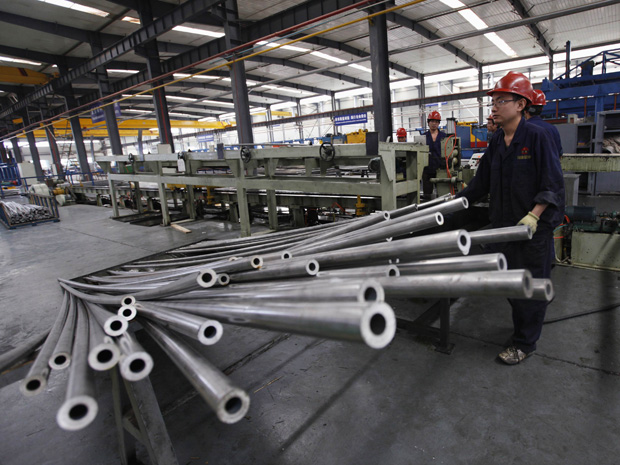
Employees work at the Qinghai Guoxin Aluminium Industry Incorporated Company workshop in Xining, Qinghai province, China
China’s primary aluminium market is still showing every sign of being in supply-demand deficit.
Stocks registered with the Shanghai Futures Exchange (SHFE) are still falling.
As of last Friday they totalled 110,016 tonnes, down by 331,153 tonnes on the start of 2011 and the lowest level since the opening days of 2008.
The change in visible inventory is widely believed to be part and parcel of a broader run-down of stocks in the country, including those held off-market.
The front part of the SHFE curve, meanwhile, remains in steep backwardation, suggesting continued short-term tightness.
The question is whether Chinese producers can respond to this deficit or whether China will return to the import market in a big way for the first time since 2009. Non-Chinese producers such as RUSAL are pinning their hopes on the latter.
Maxim Sokov, the company’s director for strategy, told Reuters earlier this month he expected China to become a major net importer later this year or early next year.
The hope is by no means new. China becoming a consistent net importer of aluminium in the same way it is of other metals such as copper has long been the aluminium industry’s holy grail.
Certainly, without Chinese help it’s going to take a long time to run down the massive stocks overhang in the Western World.
Not everyone shares RUSAL’s view. Analysts are broadly split on whether the Chinese market will self-correct or require imports to make good the internal supply shortfall.
Today’s figures from the International Aluminium Institute (IAI) leave the answer hanging for another month at least.
Chinese production of the light metal crept a little higher in August, according to data from the China Nonferrous Metals Industry Association (CNMIA) supplied to the IAI.
Annualised production rose by 118,000 tonnes last month to 18.8 million tonnes.
It wasn’t enough to offset the larger 320,000-tonne annualised decline between June and July, though.
The August creep was matched by producers in the world outside of China. Non-China production rose by an annualised 109,500 tonnes last month, once again largely reflecting higher output from new smelters in the Gulf region.
As such, global output of the light metal has been largely marking time over the last three months, holding around the 44.5 million tonne annualised rate.
The world outside of China is quite palpably not short of aluminium. But China, it seems, is. On its production dynamic will therefore rest the short-term fortunes of the global industry.
Power rationing remains the key constraint on Chinese capacity utilisation. And remember that in China this is always going to be about utilisation not capacity, of which there is plenty.
Henan province, a major aluminium production hub, saw compulsory power cuts for smelters in late July and early August. That’s why national production dipped over July and August from June’s record annualised 19.03 million rate.
This is the usual Chinese “summer power crunch,” when industrial users, particularly energy-intensive ones such as aluminium smelters, are forced to curtail output to prioritise domestic users.
Summer, though, is almost gone and the power hit on industries such as aluminium and steel has probably been much smaller than originally feared.
In theory at least power availability should now steadily improve and with it national aluminium production. In practice, though, it may not happen.
Continuing low rainfall is depressing hydro-power generation in provinces such as Guizhou.
China Southern Power Grid Corp, supplier of electricity to Guangdong, Guizhou, Yunnan and Guangxi, has warned that the hydro component of its generating system is still running at less than one third potential capacity.
Earlier this month authorities in Guizhou, which accounts for nearly 10 percent of Chinese aluminium output, put local smelters on high alert for more rationing.
The threat exists that “summer” power crunch will simply extend into “winter” power crunch, meaning that constrained aluminium production in eastern provinces offsets the commissioning of new smelter capacity in western provinces.
This will have the effect of slowing the sector’s ability to respond to the price signals emanating from the SHFE market.
Those price signals are still not strong enough to stimulate a step-change in the country’s imports of primary aluminium.
The snapshot of the August trade figures out earlier this month suggested no significant pick-up in unwrought metal imports. But the arbitrage for profitable imports is tantalisingly close.
If the window opened, it would send a powerful ripple effect through the Western market, where stocks are high but largely quarantined by financing deals.
The August production figures were always likely to show low or no-growth because of summer power rationing. Those for September will tell us far more.
Until then the jury on whether the Chinese aluminium market can re-balance without import flows remains very much out.
